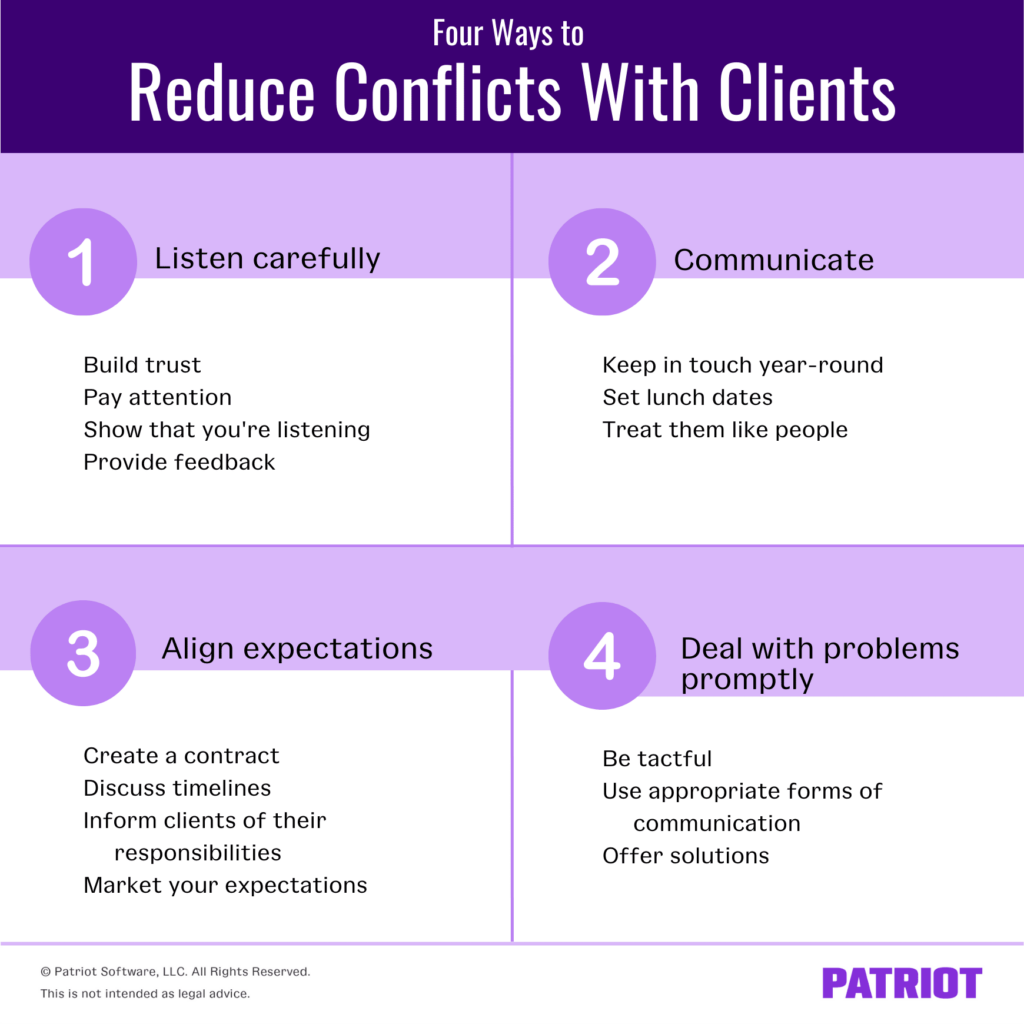We’ve all dealt with upset clients. Some don’t like your advice and others ignore it entirely. Some clients want things done yesterday and others just came to you yesterday and need things done tomorrow. Whatever the case is, rude clients are easy to come by. What can feel hard is conflict resolution with customers.
Read on to learn how to deal with rude clients and get tips to help keep everyone calm from the beginning to the end of the year.
Why are customers so rude, anyway?
There will inevitably be a client that doesn’t like the work that you do. There are many reasons why clients complain. But by knowing some of the common complaints, you may be able to prevent some of these frustrations from ever happening.
Clients are often upset because you are:
- Going too slow and need to pick up the pace
- Charging them in unexpected ways (how much do accountants charge, exactly?)
- Too opinionated and aren’t listening to what they need
- Not working as hard as they think you should be
More often than not, the main reason clients act out is because their or your expectations aren’t aligned. Luckily this is easy enough to fix.
How to deal with rude clients
There’s a chance that the conflict you have with your clients is entirely preventable. So before you switch to red alert, you may want to think about how to handle rude customers. Here are four ways to reduce conflict and restore confidence with your clients.

1. Listen carefully
First things first, listen to your client and try your best to understand where they are coming from. This should go without saying, but taking the time to understand a client’s complaint may be the quickest way to find a solution.
Often, listening isn’t as easy as it should be. Try to practice active listening to make sure that you’re dialed in. Here are a few skills to become a better active listener:
- Build trust. Listening to a client’s complaint is never easy. But if you give them a chance to speak openly and honestly about how they feel, setting things right will be easier than ever.
- Pay attention. This is easier said than done. There are a number of things in our lives and our offices that can divide our attention. Declutter your workspace and silence your phone (notifications, too!) and give your client your full attention. Eye contact can always help. And if you get defensive or come up with the perfect reply or excuse, keep it to yourself. During conflict, your job is to listen.
- Show that you’re listening. Body language and vocal cues can go a long way. Check your posture and make sure that you smile occasionally and encourage your client to keep speaking.
- Provide feedback. Just because you’re listening, making eye contact, and sitting up straight doesn’t mean that you’ve understood everything. Make sure that you have things straight by summarizing what the client said. Paraphrase what you’ve heard and ask questions to clarify points you may have misunderstood.
2. Communicate
One of the easiest ways to avoid complications is to communicate as often and openly as possible. This is also a great way to build trust with a client.
Here are a few ways to take your communication to the next level:
- Contact clients throughout the year. You can set up a schedule to get in touch with your clients or reach out whenever they cross your mind. A schedule can help you remember days that may be special for the client like birthdays or anniversaries. You don’t have to talk business either. Get to know them and show them you care.
- Set lunch dates. There’s nothing better than a good meal to relax the nerves. The best thing is that a lunch date doesn’t have to be elaborate or bust your budget. If your client has any recommendations on where to go, even better!
- Treat them like people. Your clients are just people, and treating them that way can make all the difference. Celebrate their personal and business successes when they happen and mourn their losses, too.
3. Make sure your expectations align
It’s not uncommon to think that you and your client have the same expectations, when in reality things are a little different. Making sure that your expectations are clearly understood and aligned with your customers is key.
Here are a few things to consider when aligning expectations:
- Create a contract. A contract is an easy way to make sure that everyone is on the same page. For example, a bookkeeper would include the cost of bookkeeping services and services in the contract.
- Discuss timelines. Make sure that your client understands when to expect you to finish your work. It may help to set deadlines of your own so that your clients don’t overwhelm you with last-minute paperwork.
- Client responsibilities. Give the client an understanding of their responsibilities to keep them from any late-in-the-year shocks. Keeping organized receipts or opening a separate business bank account may be the last things on their mind. You may find that a checklist helps your more starry-eyed clients.
- Marketing should reflect your expectations. To make sure you put your best foot forward, make sure your accountant marketing informs your customers of your expectations and goals.
4. Point out problems promptly
Let your client know about any problems you come across as soon as you can. This doesn’t mean abandoning all tact for the sake of speedy delivery. Choose your method of communication carefully.
For larger, more complicated issues, you may find that a meeting or a lunch date works best. But if the issue is minor, an email or a phone call could work just fine.
However you communicate, pay attention to your tone. You shouldn’t come off as a judge and jury. Let them know of the issue and that you’re here to help.
What to do if a client keeps being rude
It’s possible that your client is still upset despite your best efforts. Here are a few things you can do just in case you haven’t changed your client’s mind.
- Check yourself. Make sure that your understanding of and reaction to the situation is correct. This type of soul searching can be difficult, but ultimately helpful to client conflicts. There’s a chance that you got off on the wrong foot and need to reassess your role in the conflict.
- Bring in a third party. The root of your problem could simply be that some personalities clash. If you can, bring in another team member or partner to help.
- Change your perspective. A truly difficult client will keep you alert and on your toes, which can ultimately be a good thing for your business.
- Remind your client that you are on the same team. It may not seem like it during the heat of a disagreement, but it’s true—you and your client are on the same team. You are, after all, their trusted advisor. If things get heated, take a moment to remind your client (and possibly yourself) that you have shared goals in common.
- Offer solutions. If there are options available to fix the problem, by all means, let your client know what their best options are. Offering possible solutions is an easy way to repair client trust.
- Know when to walk away. Sometimes you try everything you can and clients continue being upset, rude, or disrespectful. If that’s the case, allow yourself to walk away. Walking away at the right time will help both you and your clients out in the long run.
This is not intended as legal advice; for more information, please click here.


